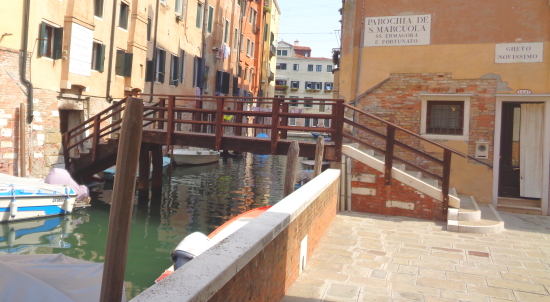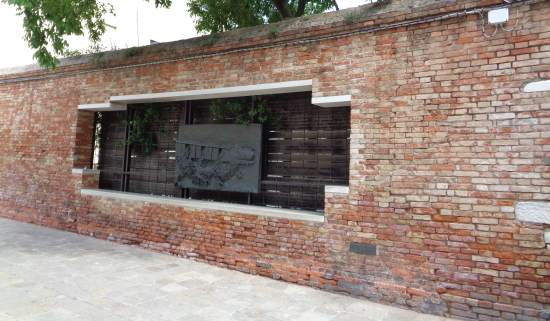|
Ghetto Venice (Jewish Quarter) |
||||||
Insider tip: Travel comfortably without queues, buy tickets online beforehand:
|
The ghetto (also called the ghetto) was the residential area of all Jews in Venice from the 16th century to the end of the 18th century. No Jew was allowed to live anywhere else but in the narrow, small area. Jews were allowed to leave the ghetto, but only during the day. There are still canals around the ghetto today, and you can still only get into the Jewish quarter over a few bridges. In the past, the gates were closed at night. Today only a few Jews still live here. There are not many Jews in Venice anymore. Many were murdered during the Nazi era. Now the majority of non-Jews live in the former ghetto.
As a tourist you can cross one of the bridges over a canal through a gate into the Jewish quarter.
For a long time, the quarter was only one hectare (about one square 100 x 100 meters) in size. Several thousand Jews lived here. Only after the decline of the Republic of Venice was the Venice Ghetto abolished by Napoleon in 1797. After that the Jews were allowed to live elsewhere in the city. During the time of the Venice Ghetto, the Jewish inhabitants were only allowed to exercise certain professions, and this restriction was also lifted under Napoleon. Today, about 500 Jews still live in Venice, decimated by the Holocaust. Only about 50 of them live in the area of the former ghetto. Nevertheless, it is still the center of Jewish life in Venice and the surrounding area. There is a Jewish butcher, a Jewish bakery and a good restaurant. Jewish Museum Venice The tourists usually visit the Jewish Museum. Two of the three synagogues of the ghetto are in the museum and can be visited during the museum visit. In the "Museo Ebraico di Venezia" (Jewish Museum of Venice) there are several rooms with very interesting exhibits from the Jewish quarter of Venice. The museum is located directly on the main square "Campo del Ghetto Nuova". First the museum visitors pass through a synagogue, then through the exhibition rooms and finally through another synagogue.
In the museum of the Venice Ghetto you can see textiles, religious objects and other things from the life of the Jews in the district. The former life of the inhabitants is well represented. Tickets for the museum can be bought in advance on the Internet. Tickets are available on this website. Below is a bookshop on the subject of the Venice Ghetto. The controls at the entrance of the museum are stricter than at the airport. The crowd at the Ghetto-Museum Venice is often large. Square Campo del Ghetto Nuova This is the large central square of the Venice ghetto. Opposite the museum is an interesting, large memorial to the Holocaust.
On the square there are some trees and benches to rest. The Italian police is here all the time, as everywhere in Europe, Jewish institutions unfortunately have to be specially protected. The Ghetto Venice is actually an island surrounded by water. In various places you can get out of the ghetto today, as then, over bridges from the main square. The tall houses around the square Campo del Ghetto Nuova are striking. Many Jews lived here for a long time, but the space was very limited. So they built into the heights. Even the synagogues are partly on upper floors. Stores and Restaurants Venice Ghetto In the butchery and bakery, slaughtering or baking is done according to the rules of the Jews. You can go inside and look at the things. The kosher restaurant is a few meters away from the actual ghetto in the direction of the Canal Grande. There is also a store where art is sold and a souvenir store. In the house with the museum is a bookstore. The entrances to the ghetto with the bridges and the main square Campo del Ghetto Nuovo should not be missed. Name Ghetto Geto means translated foundry. Before the settlement of the Jews there were several iron foundries in the area. Hence the name Geto, and later the ghetto and ghetto. The Jewish ghetto in Venice was so well known that later in other countries too, districts where minorities lived were called ghettos. This is how the word ghetto originated in German, English and many other languages. Film about the ghetto (from Youtube, about 10 min)
Approach Ghetto Venice You leave from Venice Central Station, then turn left on the main tourist path towards the Rialto Bridge. After about 200 meters, first along the Vanal Grande, you come to a bridge over a wider canal, which flows into the Canal Grande on the right for 50 meters. Cross the bridge and go straight on for about 100 meters. Then turn left and after about 50 meters you come to the Jewish Quarter of Venice. The nearest water bus stop on the Grand Canal is "S. Marcuola-Casino", line 1 only, but it is better to walk from the main station (about 500 meters from the main station or 200 meters from the water bus stop). The ghetto is a kind of island, surrounded by canals. But you will quickly find an entrance over one of the wooden bridges.
Our tip:
Buy tickets for waterbuses
beforehand
It is not always easy to
buy tickets abroad. You don't know where to buy tickets,
foreign ticket machines are difficult to use, there are
language problems, queues, etc.
The 1, 2 or 3 day valid
tickets for the waterbuses (ferries) in Venice are needed
by almost every tourist. These tickets can now be bought
on this english website.
The tickets for the bus
from Venice airport to the city are available
on this page in English language.
|
|
||||



